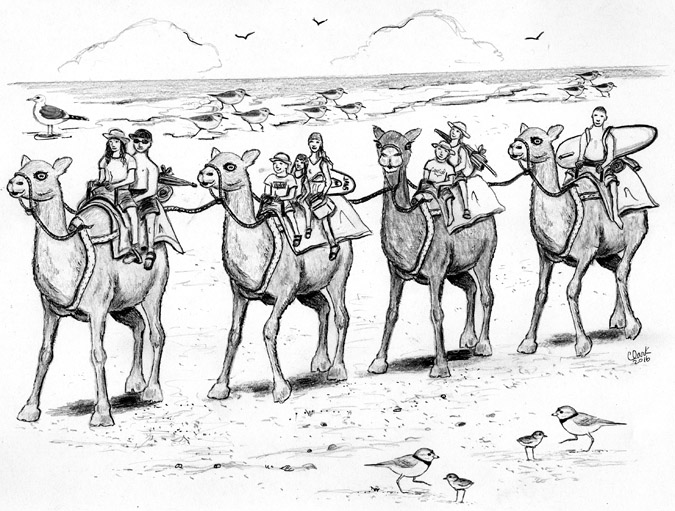
Dear Bird Folks,
For years we have been reading about the battle between the lowly Piping Plovers and those mean SUVs. But recently I heard that a new plover-friendly plan has been agreed upon. Apparently this plan would keep vehicle traffic off the beaches, while at the same time allow people to have access. Could you explain?
– Stephanie, Orleans, MA
This is a good one, Stephanie,
Ordinarily I avoid the plover-SUV topic. It’s like talking about the Presidential election; no matter what you say, someone is going to throw a tomato. Recently, however, a creative plan has been worked out and both sides of this issue are excited about it. The plan does not involve vehicles driving on the beach; instead, it has to do with camels. Yes, camels. I’ll bet you didn’t see that coming and neither did anyone else…except for one creative grad student.
In the spring of 2009, Hal Atkins was a biology major at the AFD Institute, near Topeka, KS. During spring break, Hal and his friends decided to take a trip to a nearby ranch. Most area ranches use horses or mules to carry visitors, but this one only used camels. This was just the fun adventure Hal and his friends were looking for. After about an hour on the trail, Hal’s camel stopped in its tracks and wouldn’t move. Then one of Hal’s friends pointed to something on the trail – a covey of ten baby quail, all hunched down and “hiding.” The humans could barely see the cryptic birds, but the camels had no trouble. As Hal sat there wondering what would happen next, the camels slowly started to move…but only after giving the quail a wide berth. While most of Hal’s friend thought, “stupid camels,” but Hal saw this event differently. When he got back to Topeka he decided to do some research. This is what he found out.
In addition to being big and a little smelly, camels have excellent vision. They have evolved superior eyesight in order to avoid stepping on one of North Africa’s deadliest creatures, scorpions. If camels see something odd they freeze and then slowly proceed to move around it. After learning this, Hal decided to run some experiments. First, he went out and rented a camel (I guess you can do such things in Kansas). He next placed some creatures in the camel’s path. Initially, he used turtles and then frogs; finally, he placed ducklings in front of the camel (now named “Humper”). Each time Humper reacted exactly like the camels did that day at the ranch. Upon hearing of Hal’s experiments the Department of the Interior invited Hal (and Humper) to run some live trials near Piping Plovers’ nests on Fire Island, New York. And as advertised, Humper totally avoided all the baby plovers. Go, Humper!
Fast-forward to the winter of 2016 when the Feds met with local Cape officials and both parties agreed to try a similar experiment in Orleans. Based on the agreement, thirty camels are to be shipped from Kansas and will be used to ferry people, along with their coolers, surfboards, fishing rods, etc. (sorry, no pets) to anywhere on Nauset Beach. Folks with a 2016 ORV beach sticker can ride the camels for free, while there will be a nominal charge for anyone who just wants to go for a ride. Pretty cool, eh?
Ironically, animal rights groups have no problem with the camel program. They understand that unlike horses and mules, camels don’t mind the summer heat and can easily handle walking on beach sand. In addition, camels are the only pack animals that can be “house broken.” After the trainers lead the camels to a designated “rest room,” they (the animals) are good for the rest of the day. This means there will be no “surprises” left on the trails (or on the bottom of people’s flip flops).
Where will the camels spend the night? Soon a corral will be set up on the town’s village green, next to Snow Library. I’m sure the local garden club won’t be happy to hear that their beloved green will be used to house camels, but there isn’t much they can do about it. The Bovine Ordinance of 1755 clearly states that all village greens in the Commonwealth can be used for the sheltering of farm animals and the Feds fully intend to take advantage of this ordinance. (I wonder if they were thinking about camels in 1755?)
Other than the garden club, I think the rest of the town is going to love the new arrivals. Each morning the camels will leave the village green and parade down Main Street to their assignment at the Nauset Beach parking lot. Folks will be encouraged to visit the unassuming camels and even feed them their favorite snack food, which is, of all things, Twinkies. It seems Yellow #5, the ingredient that gives Twinkies their famous color, also helps give the animals a soft golden coat. (That’s another reason why Twinkies are the best.)
I think the camels are the perfect solution for the long SUV vs. plover battle, Stephanie. Not only will this save the birds, it will also help stodgy old Orleans become fun again. According to a press release, Hal Atkins, along with his sidekick, Humper, will be coming to town to kick off the program and meet anyone who wants to see the camels. Hal also says he’ll be happy to sign autographs (but I’m not sure about Humper). Either way, it promises to be quite the festive event. (Don’t forget the Twinkies.) It all takes place at the new corral next to Snow Library in Orleans this coming Friday, April 1st.